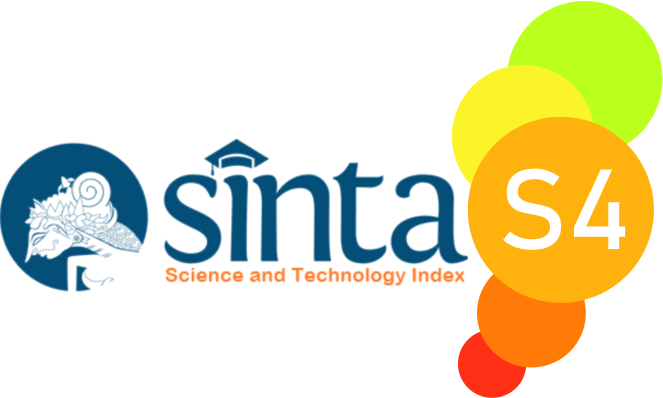LEARNING TO MEAN SEMIOTIC CODE IN THE NOVEL AROMA KARSA BY DEE LESTARI
Abstract
The problems contained in this paper are described about interpreting what semiotic codes are described in gnomics, proaretics, and hermeneutics in the novel Aroma Karsa by Dee Lestari? and how do the three meanings of the code provide an overview of the detailed learning in Dee Lestari's Aroma Karsa novel? The purpose of this study is to learn in detail about learning to interpret the code contained in the novel Aroma Karsa by Dee Lestari, and to understand the function of meaning contained in the myth in detail from the events in the novel Aroma Karsa by Dee Lestari. The data sources for this paper are: the novel Aroma Karsa, while the check-list data collection techniques and data collection guide instruments have been named. The results of this paper on the gnomic code are related to the myth about a Dwarapala village that inhabits in Alas Kalingga. The residents still believe in the descendants of Mahesa Guning. Life relies on God and supernatural powers. The hermeneutic code deals with the riddle or mystery of the mindset of a man who is too greedy and ambition to get wealth by stealing a box in a closet belonging to a royal relative. Learning about what was stolen, he became greedy to get the scent of Puspa Karsa to be known in the Asian region. Raras invites his adopted son, Suma, who has a keen sense of smell, to find Puspa Karsa in Dwarapala Village in the Kalingga forest. The results of this paper are divided into three, namely: The kernel contains a normal story, the kernel experiences back-lighting and the kernel experiences normality and then climaxes and ends. The stimulation stage is at Kernel 7-42, while the criticality is kernel 43-47: Conflict is at kernel 48 and Complicated Kernel is 49, 50. The climax is at kernels 55, 56, 57, 58, while Leraian is at kernels 59 and 60. The solution is in the kernel. 61.
References
Bertens, K. (2011). Ethics. Jakarta: Gramedia.
Burhanuddin, R.(2000). Individual Ethics. The Archetype of Moral Philosophy. Jakarta: Rineka Cipta.
Ghazali, I. ______.' Ihya Ulum al-din. Juz III, Isa al-Babi al-Malaby wa Shirkah.
Hoed, B.H. (2011). Semiotics and Socio-Cultural Dynamics. Jakarta: Bamboo Community.
Jabrohim et al. (2001). Literary Research Methodology. Yogyakarta: Hanindita Graha Widia.
Junus, U.(1981). Myth and Communication. Jakarta: Sinar Harapan Publishers.
Miles, Matthew B and Huberman, A.M. (1994). Qualitative Data Analysis, UK: Sage Publication.
Moleong, Lexy J. (2004). Qualitative Research Methodology. Bandung: Rosdakarya.
Nurgiyantoro, B. (2007). Theory of Fiction Studies. Yogyakarta: Gajah Mada University.
Pradopo, R.D. ( 2003). Literary Research Methodology. Yogyakarta: PT. Hanindita Graha Widya.
Ratna, N. K .(2016). Literature and Cultural Studies, Representation of Fiction and Fact.Yogyakarta: Student Library.
Roland, K B.(1994). Elements of Semiology (trans. Kahfie Nazaruddin). Yogyakarta: Jalasutra.
Roland, K.B.(1957). Mythologies. New York.
Sobur, A. (2003). General Psychology. Bandung: Faithful Library.
Sobur, A. (2009). Semiotics of Communication. Ed I. Bandung: Youth Rosdakarya.
Sobur, A.. (2004). Media Text Analysis. Ed. III. Bandung: Rosdakarya Youth.
Sobur, A. (2004). Media Text Analysis. Ed. III. Bandung: Rosdakarya Youth.
Sunardi, (2002). Negative Semiotics. Yogyakarta: Canal.
Teeuw, A. (1984). Literature and Literature. Jakarta: Pustaka Jaya.
Wolff, J. (1981). The Social Production of Art. London, Macmillan.
Zoest, A.V. et.all (2001). Miscellaneous Semiotics. Jakarta: Gramedia.
Zoest, A.V.(1993). Semiotics: About Signs, How They Work, and What We Do Do it with him. trans. Ani Soekowati. Jakarta: Sumber Agung Foundation.

Journey: Journal of English Language and Pedagogy by http://ejurnal.budiutomomalang.ac.id/index.php/journey/index is licensed under a Creative Commons Attribution-ShareAlike 4.0 International License.






